Bertram 33 SF
by David Pascoe
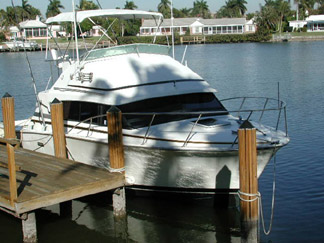
What can you say, it's another Bertram? Actually, quite a bit, for this is one of my favorite Bertrams, one of those boats that, when it first came out, I didn't much care for it. But over the years has slowly revealed her strengths as just an all-around great boat. Granted, you got to like this style boat to begin with, but if you do, there's a lot to talk about here.
Let's start with the fact that the 33 heads up an entire series of similar model Bertrams that begins with the 28, and moves to several different 30 foot models. What distinguishes so of these boats is the great design styling that has held up so well over the years. Regardless of age, they still look good, proving the point that good design really does account for something.
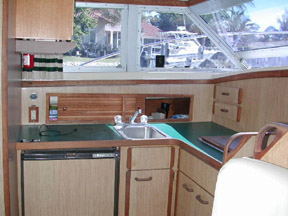
Despite its rather low profile, this 33 is a big boat. It has a 12'8" beam and the gas model weighs in at 20,730 lbs., so she's no lightweight. With a pair of 454 Crusaders, her deep vee and weight is a bit much for a pair of gas engines, resulting in a cruise speed of only 21-22 knots, a bit slow for this size boat. If there are any major negatives to this boat, that's it. On the other hand, this is a superb candidate for repowering with diesels as the engine spaces are large and the job fairly easy.
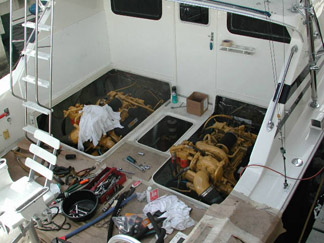
This twenty year old beauty just received a new pair of Cat 3208's along with generous cash in-fusion to make her look like new.
For a thirty-three footer, she boasts something you'll rarely ever find with this size boat: a large cockpit, generous cabin spaces, and a large flybridge capable of seating five comfortably with no crowding. Having so much room in all three areas is achieved as a result of having the rather lengthy house set far forward which gives you a short foredeck, but a lot of space on the bridge without taking up cockpit area.
The cabin area isn't going to please any socialite as there is no room for entertaining. But there's more than enough room for two people overnighting with an adequately sized vee berth cabin forward. The main cabin has enough room to allow two people to move around freely, and contains a good sized galley and convertible dinette which converts into a nice double berth. Altogether, it's not hard to see a couple spending a week or so onboard for a vacation cruise or extended fishing trip. Yet another thing I like about the cabin is that, though the windows are not large, they extend completely around the perimeter of the cabin, mostly at eye level, making for a very bright and airy interior with fantastic visibility. I don't know about you, but I like to see what's going on outside when I'm not at the helm.
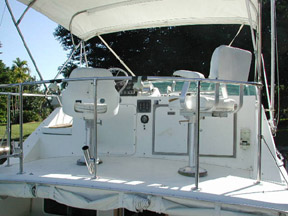
The L-shaped galley has the standard large Norcold under counter reefer, a medium sized sink and the usual Homestrand combination alcohol/electric cooktop that surprisingly hadn't been updated. The interior is the usual Bertram Formica city with a twist. The counter tops are hunter green with matching dinette table and upholstery. The interior dcor on this 17 year old boat was reportedly original and, despite its age looked remarkably good though it lacked any kind of window treatment. The window frames were completely exposed and showed a surprising lack of corrosion and no sign of leakage except for the usual around the two lower windshield opening sections. Only six inches high, these vents are great and will bring in a tremendous amount of air flow if you can't or don't want to use the A/C. Coupled with the two opening windows in the aft bulkhead, plus the side windows, you just won't find a boat with better natural ventilation.
Whenever you find a boat with exceptionally large interior space, you'll usually find that much of it comes at the expense of storage space. Not so on this boat, for there is a surprising amount of easily accessible interior storage space.
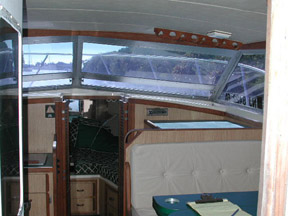
The head compartment is adequately sized, but there's nothing fancy about it. It doubles as a shower stall with a wrap around shower curtain that is anything but convenient. I'd be more inclined to shower out on deck than trying to avoid watering down the whole interior by using this silly affair.
Moving out to the cockpit, the first things you notice are the low profile motor boxes and the huge overhang of the house top, which is something like three feet. Many will appreciate this feature as neat place to get out of the sun or rain without having to hole up inside the cabin.
Motor boxes may seem like an annoyance or a terrible waste of good deck space, but keep in mind that this is only a 33 foot boat. In order to get a nice low and level cockpit deck, the raised motor boxes are the trade-off. Yet in return for that bit of inconvenience, you also get a nice place to sit or temporarily store stuff out of the way. The area is large enough that you can even place deck chairs up there and sit in them.
Engine access, as you can see from the photos, couldn't be better, whether you got gas or diesels. This is a wonderfully easy boat to maintain, from tightening up the stuffing boxes, to changing spark plugs and cleaning sea strainers -- hey, everything is easy to reach. Most of these boats will have generators, and here is a big sore spot: that dang leaky aft hatch cover that pours water all over the genny. It's hard to keep a generator dry back there. Even so, the original Onan 6.5 Kw rattletrap ball of rust was still running . . . . barely.
The Bridge
The bridge is as large and well designed as could possibly be on a boat this size. The console is set aft with passenger seating in front. This rather standard and convenient design is typically found only on larger boats. The space for the two pedestal helm seats aft of the console leaves enough room to get by them without causing the helmsman to move -- a rarity on even much larger boats, and a point that I've always considered critical. If you don't have adequate room around the helm chairs without getting all tangled up in them, then the boat is no damn good for fishing or diving as you'll spend most of your time getting untangled from the dang chairs. No problem with the 33, this one's designed right.
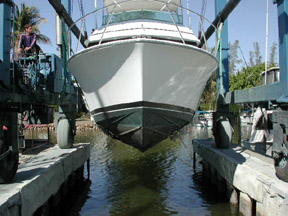
You could certainly gripe about the helm panel and wonder what the hell was the designer thinking when he did this one. You know that on the 28,30 and 31 there wasn't space for an adequately sized panel, but that can't be the excuse here. No, what the designer did here was to use the design of those previous models, with a most unsatisfactory result. Meaning that there is no space to mount your gizmos forward of the wheel. However, off to the right there is a large flat area on which you can either build an electronics box, or bracket mount them, plus you've got one of those goofy hinge-out vertical cabinets in which to mount a radar, now that radar units are half the size they used to be.
Despite these relatively minor gripes, the one big plus is lots of elbow room. You'll note that the wheel is up plenty high, as are the engine controls. Then there is a nice foot cove built into the front of the helm so that you can slide the seat far forward for seated operation without having to hunch over and get sore shoulders due to the chair/wheel positioning not being right. Altogether, I'd give this bridge an A rating.
Construction Issues
This may come as a surprise to some, but this boat has rather weak hull sides, particularly up in the bow area where a lack of adequate framing results in hull side flexing that can result in rather extensive, but very hard to see, gel coat stress cracking. This seems to be related to the high stresses that come with stuffing the bow into a wave. In any case, this condition had existed for a long time with no implication for potential hull failure. Bertram has always used the very hard Cook Chemical gel coats which are brittle and therefore very prone to stress cracking.
Otherwise, this model line has never turned up any hull faults in any of the many boats I have surveyed. Stringers and framing is all glass over plywood. But not to worry, it is all fir plywood of the highest quality that is remarkably rot resistant. We've seen this stuff immersed in water for decades with nary a sign of rot.
The decks on this boat are cored, Balsa in some places, plywood in others. Yet we've seen remarkably few instances of core rot, owing to designers who know what they're doing. And though the hull/deck joint is bolted, the fiberglass thickness at the gunwales is much too thin, leaving the toe rails excessively weak and highly prone to stress cracking. In fact, you'd have a hard time finding one of these boats on which the toe rails didn't have some stress cracking, and sometimes a lot. It's not really a problem short of the degraded appearance, and most people just accept it for what it is. And yes, it's got those God-forsaken aluminum rub rails, attached with the bolts that hold the deck on, so replacing any damaged rail sections is related to the ability to get at the nuts on the inside, which isn't always easy. This can, in fact, become a costly repair problem.
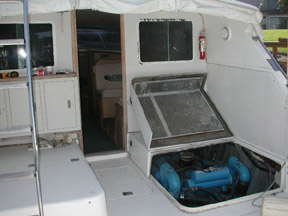
A pair of Crusaders almost look lost in these big holes
Another interesting point is the depth of the bilges. Though the cockpit is quite low, you can go down through the center hatch between the engines and still there is room to crawl around down there. The batteries are located aft between the engines, and you can get down there to service them. Then, you lift the hatch on the forward bilge area and find that it's almost like a basement down there. Standing on the hull bottom, the cabin sole is chest high. The point here is that there is loads of good storage space in this area. Plus you've got the A/C, water heater, pumps and other stuff down there and it's all easy to reach. Need to add something? No problem, installations are a snap on this boat because there's no problem stringing wires, running plumbing or just finding space to mount something.
Long Term Durability
At seventeen years old, one look and it was plainly evident that this particular boat had had a rough life. It was poorly maintained by one or more severely under-funded owners with a propensity for never doing anything right. Yet despite this long term neglect, this boat has held up remarkably well. It stands as a rare testament to the art of boat building when accomplished by skilled and knowledgeable people who care about the quality of their products. A couple of shining examples are the aluminum window frames which showed remarkably little corrosion. Another is how the badly faded gel coat was easily restored to a gleaming luster after we hand tested a small spot with a mild compound -- by hand!
Performance
Well, it's a Bertram and she handles the seas about like you'd expect. Especially with that very low center of gravity, she doesn't roll much and what roll there is, is a very kindly roll. But, like most Bertrams of her size, she is fairly wet. That's the price you pay for a full bow with lots of interior volume.
She handles a nasty head sea medium well. Note that her entry is not super fine or particularly deep. With the bridge being so far forward, you will get more of a sense that she's pounding because you are sitting right up there in the pounding area, in contrast to a boat with the helm further aft. On a scale of one to ten, I'd rate her performance at around eight. As for production boats of her class, I can't think of anything better except the 33 Blackfin.
Our survey example had a pair of clapped out Crusader 454's that wouldn't turn up beyond 3800 RPM for a top speed of 22kts. With fresh engines you could expect to see 24-25 knots at an uncomfortable 36 gph fuel burn on a 22 knot cruise. Shown in a nearby photo is a 33 that has been totally refurbished and repowered with a pair of Cat 3208, 425 hp diesels that turned her into a real speed demon (32 kts). These engines were an original option and all these boats were designed to take that kind of power. If you wanted to repower with Cummins B or C block engines, the engine boxes would have to raised up about 6", but the Cats will fit with no modifications except shafts and struts.
Because of their inherent good looks and great design features, these 33's are increasing becoming a hot item for serious refurbishment jobs. By serious, I mean people lavishing up to several hundred grand on such projects. That little fact probably tells you more about what some people think of this boat than anything I could say.
Posted September 10, 2001
 Visit davidpascoe.com for his power boat books
Visit davidpascoe.com for his power boat books 














David Pascoe is a second generation marine surveyor in his family who began his surveying career at age 16 as an apprentice in 1965 as the era of wooden boats was drawing to a close.
Certified by the National Association of Marine Surveyors in 1972, he has conducted over 5,000 pre purchase surveys in addition to having conducted hundreds of boating accident investigations, including fires, sinkings, hull failures and machinery failure analysis.
Over forty years of knowledge and experience are brought to bear in following books. David Pascoe is the author of:
In addition to readers in the United States, boaters and boat industry professionals worldwide from nearly 80 countries have purchased David Pascoe's books, since introduction of his first book in 2001.
In 2012, David Pascoe has retired from marine surveying business at age 65.
On November 23rd, 2018, David Pascoe has passed away at age 71.
Biography - Long version